Special Feature: Products Sally Recommends
Touring with a BMW in the Shadow of Stirling Castle in Scotland
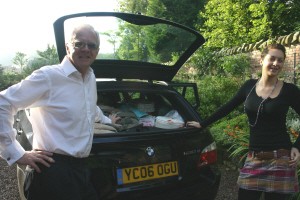 Living, as we do, on the Scottish border in Berwick-upon-Tweed, Scotland is, quite literally, on our doorstep. But as so often happens with great things in your own back yard there is a tendency to ignore them in favour of travelling further afield. Over the next few months we intend to put that right!
Living, as we do, on the Scottish border in Berwick-upon-Tweed, Scotland is, quite literally, on our doorstep. But as so often happens with great things in your own back yard there is a tendency to ignore them in favour of travelling further afield. Over the next few months we intend to put that right!
The Scottish landscape is bewitching. The rich farmlands of the Borders and the mighty River Tweed, where you can catch a wild silver salmon, the mountains, pine forests and heather moors where grouse call, golden eagles glide and foaming rivers seem to flow down every valley makes it a land tailor-made for touring by car. Long and winding roads skirt the higgledy-piggledy coastline of the Atlantic Ocean and lead you along shimmering lochs or high into the mountains for dramatic views. Best of all the roads are open and uncluttered, what Mr Toad in Kenneth Graham’s Wind in the Willows, first published 100 years ago, called “The real way to travel! The only way to travel!”
Mr Toad would have approved of our chosen car for the first of these expeditions - a BMW 530d M Sport Touring. Its sporty pedigree brought it equipped with a manual gearbox which at first we were a little disappointed about (these days we are fans of automatic gear change!) but we soon realised how versatile this gearbox is. As well as letting you use the gears and rev the car as hard as you like it was entirely forgiving if you decided to leave it in sixth gear and pull away from 25mph!
The history of Scotland is a long one. The Romans invaded Scotland but went off it as a prize, for they got no further than the lowland areas, leaving the Highlands and Islands untouched. It took until 1603 when Elizabeth 1 died for the union of the English and Scottish crowns to finally unite the two countries after many centuries of bitter fighting. James Vl of Scotland succeeded to the English throne and became James 1 of England. He was king of both countries and for the first time the two crowns were united.
Stirling Castle is one of the oldest in Scotland. Legend has it that King Arthur took it from the Saxons but there is no evidence of a castle standing here before 1124 and the present building dates from the fifteenth and sixteenth centuries. It sits on a rocky crag dominating the surrounding countryside and around it the town of Stirling itself has grown up in its shadow.
Before setting off, packing the car was made easy by the tailgate which allows the rear window to be opened separately. Handy if you are carrying a lot of bags because smaller items can be loaded through the back window or, if it’s just a bit of shopping you are picking up, instead of opening the large tailgate you can slip it through the glass window. It is also particularly useful for carrying a long fishing rod from one beat of the river to the next. You simply let the tip of the rod stick out the back window. On this occasion we were not planning to go salmon fishing but you never know in this land of rivers full of trout and salmon. The opportunity might arise. Next we programmed Stirling into our navigation system and off we went.
Throughout our motoring life we have owned a number of BMWs, starting with a 3 series many years ago and I can remember feeling very proud of the first one, a gleaming red brand new 320 which in the first week completely let us down when the gear stick somehow became detached from the gears and it had to be towed back to the garage! Undeterred we got through one or two more and finally ended up with the predecessor to this one – a diesel 520d touring. That was fifteen years ago and here we were with the very latest model and what a beauty. Even the colour is worth mentioning - carbon black with black Dakota leather seats.
The diesel engine is almost silent and of course the power of the car is astonishing. But what really makes this car so amazing are the safety features which only a few years ago were simply not available. This one, for example, sported a host of airbags including door airbags for driver and passenger, head airbags for front and rear occupants, stability and traction control, anti-lock braking, brake force display, corner brake control and a tyre puncture warning system with run flat tyres. With all this on board there is a tendency to think that the car is invincible but of course it isn’t. However, it is particularly nice to know if you are travelling down a highway at speed and a tyre blows all you’ll know about it happening is a warning light that tells you to drive to the nearest garage to get it fixed!
On the road the car was effortless. With cruise control engaged on the main roads, air conditioning on and cocooned in the car’s comforting surroundings, the miles quickly slipped by. The on-board computer fed us information about fuel consumption and range, ambient temperature and average speed and told us when we could expect to arrive at our destination. The iDrive controller and display screen gave us control of our entertainment and navigation.
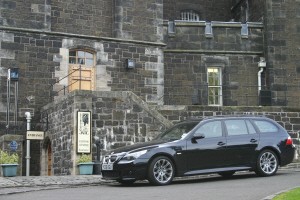 Like a homing pigeon arriving at its loft the BMW climbed the hill to Stirling Castle. On our way up we couldn’t resist stopping at the Old Town Jail. It was a chance to see what being a prisoner 150 years ago was like. It was quite a surprise. A very good local actor plays the part of hangman, jailer and prison governor and frightens the hell out of you! Several of the cells are open for inspection. Afterwards you leave rather glad to be let out but taking with you a real sense of what it was like to have been locked up. And it wouldn’t have taken much to put you in there. All you had to do was steal a chicken or some food from a shop or some bed sheets and you could be in there for years.
Like a homing pigeon arriving at its loft the BMW climbed the hill to Stirling Castle. On our way up we couldn’t resist stopping at the Old Town Jail. It was a chance to see what being a prisoner 150 years ago was like. It was quite a surprise. A very good local actor plays the part of hangman, jailer and prison governor and frightens the hell out of you! Several of the cells are open for inspection. Afterwards you leave rather glad to be let out but taking with you a real sense of what it was like to have been locked up. And it wouldn’t have taken much to put you in there. All you had to do was steal a chicken or some food from a shop or some bed sheets and you could be in there for years.
When you first glimpse Stirling Castle sitting on its volcanic hunk of rock it looks spectacular. Go inside and then look out from its walls and the views are unbelievable. Not surprisingly Stirling occupied a key position in Scotland’s struggles for independence and all around the castle are the battlefields where these bloody struggles took place. But the great tracts of land below the castle also provided hunting grounds where deer and wild boar roamed, and there is a an interesting viewing spot on the walls where the ladies often stood and watched their brave men chasing down the wild beasts on horseback.
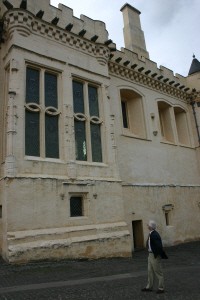 The most dominant part of the castle is the Great Hall probably built by James lV between 1500 and 1504. It was the king’s way of showing off on state occasions and is the largest ever built in Scotland, nearly 150 feet long by almost fifty feet wide. Heated by five giant fireplaces it was the perfect venue for huge banquets. One of the most spectacular occurred at the christening of Prince Henry in 1594. As part of the celebrations a huge wooden ship, with forty foot masts, was wheeled in and from it seafood was dished out to the guests and then it fired brass cannons as a salute to the Prince!
The most dominant part of the castle is the Great Hall probably built by James lV between 1500 and 1504. It was the king’s way of showing off on state occasions and is the largest ever built in Scotland, nearly 150 feet long by almost fifty feet wide. Heated by five giant fireplaces it was the perfect venue for huge banquets. One of the most spectacular occurred at the christening of Prince Henry in 1594. As part of the celebrations a huge wooden ship, with forty foot masts, was wheeled in and from it seafood was dished out to the guests and then it fired brass cannons as a salute to the Prince!
Hot on the trail of these fascinating tales of the life and times of the aristocracy in Scotland, Ronald Eden, who just happens to own the beautiful Cromlix estate close to Stirling, has spent most of his life researching and writing about his forbears. The result is a fascinating book called Going to the Moors and another book he is presently working on about the history of Cromlix itself.
We had arranged to meet him at Cromlix House, now a hotel after the Edens decided to go into the hotel business some twenty five years ago, although they are now out of the day to day running of it. Under new ownership it is in the very capable hands of Benito Gundin the hotel’s Spanish manager.
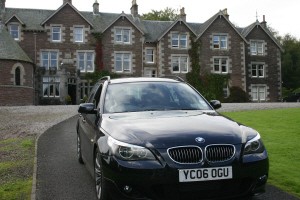 It has been the fate of many of the old lodges, castles and houses to be turned into hotels but, depending on the owner’s philosophy, they can offer a surprisingly authentic taste of what it must have been like to visit Scotland towards the end of the nineteenth century. In some cases even the plumbing has stayed the same with huge cast iron baths and wash down closets still in situ! Cromlix certainly falls into that category and it pleases the Eden family that the old house is doing what it does best - entertaining large numbers of guests.
It has been the fate of many of the old lodges, castles and houses to be turned into hotels but, depending on the owner’s philosophy, they can offer a surprisingly authentic taste of what it must have been like to visit Scotland towards the end of the nineteenth century. In some cases even the plumbing has stayed the same with huge cast iron baths and wash down closets still in situ! Cromlix certainly falls into that category and it pleases the Eden family that the old house is doing what it does best - entertaining large numbers of guests.
“A great deal of business, and even politics, was discussed in these old houses,” Ronald Eden assured me. “Kings and queens, prime ministers, wealthy industrialists and the aristocracy - they all found the peace and quiet away from the hurly burly of London extremely agreeable.” Then there was the question of illicit liaisons. Not always spoken about but certainly practiced and these romantic hideaways undoubtedly brought plenty of opportunities for trysts, either above or below stairs! “But the real sadness,” Eden reminds me, “is that many of these buildings are no longer with us.” Too big and costly to keep up they were demolished after the Second World War.
From the castle to Cromlix took a mere fifteen minutes and using the iDrive to programme in Cromlix on the navigational system we slipped away from the castle not needing to worry if we were travelling in the right direction. On the narrow roads leading to Cromlix we chucked the car about a bit, testing it on the corners and it clung like a limpet. In short it never put a foot wrong. From the moment we entered the hallway Benito was there to greet us. “Welcome back and very nice to see you again,” Benito said with a smile. “Like the car by the way.” He had watched us sweep up the driveway and was obviously impressed.
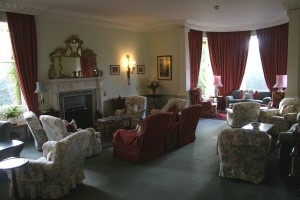 We were in time for afternoon tea and it came with home made fruit cake and biscuits. Before dinner we managed a walk to one of the nearby lochs. This was our opportunity to go trout fishing for either brown or rainbow trout but there wasn’t much time so we declined in favour of watching another guest casting a long line for a number of fish that were dimpling the surface. He had successfully landed a 5lb rainbow trout so he was very happy.
We were in time for afternoon tea and it came with home made fruit cake and biscuits. Before dinner we managed a walk to one of the nearby lochs. This was our opportunity to go trout fishing for either brown or rainbow trout but there wasn’t much time so we declined in favour of watching another guest casting a long line for a number of fish that were dimpling the surface. He had successfully landed a 5lb rainbow trout so he was very happy.
A hot bath and it was time for dinner in a dining room decorated in classic dark red wallpaper overlooking the gardens. We had scallops, mushroom soup, beef and lamb, all perfectly cooked and quite delicious, followed by a superb blueberry and almond tart. Coffee and home made chocolates completed the night and we took little persuading to enjoy a good night’s sleep. Head Chef Steve MacCallum, who arrived to work at the hotel at the same time as Benito, is producing superb food from his kitchen. Not surprisingly much of it is based on local ingredients such as wild salmon, game and local meat. It offers extraordinary value for money. Meanwhile, like all good managers, Benito is there night and day making sure everything runs like clockwork.
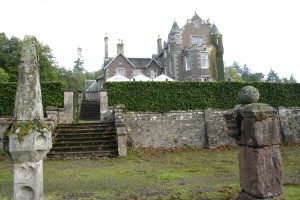 Breakfast the next morning was a treat. With such favourites as porridge and the full whack of bacon, eggs, black pudding, sausages, toast and marmalade it set us up for our journey home. We couldn’t help thinking of Mr. Toad again from Wind in the Willows. The open road for him was, “The poetry of motion!” With a car like the BMW 530d M Sport Touring we had to agree.
Breakfast the next morning was a treat. With such favourites as porridge and the full whack of bacon, eggs, black pudding, sausages, toast and marmalade it set us up for our journey home. We couldn’t help thinking of Mr. Toad again from Wind in the Willows. The open road for him was, “The poetry of motion!” With a car like the BMW 530d M Sport Touring we had to agree.
GETTING THERE
Keith and Lynne travelled from their home in Berwick upon Tweed in a BMW 530d M Sport Touring.
For more details on this model and the full range of vehicles: www.bmw.com
STIRLING OLD TOWN JAIL
St. John Street, Stirling FK8 1EA
www.oldtownjail.com
STIRLING CASTLE
Open April-September 9.30am-6pm daily
October-March 9.30am-5pm
www.historic-scotland.gov.uk/stirlingcastle
WHERE TO STAY
Cromlix House Hotel, Kinbuck, Near Stirling, Perthshire, FJ15 9JT
Telephone: 0044 (0) 1786822125
www.cromlixhouse.com
Only 20 minutes from Stirling, 45 minutes from Glasgow and 1 hour from Edinburgh.
Closest airports: Glasgow 45 minutes, Edinburgh 1 hour.
RECOMMENDED READING
Portrait of Britain, published by Dorling Kindersley.
![]()
Husband and wife, Keith Allan and Lynne Gray are travel writers and photographers based in Berwick upon Tweed on the English/Scottish border. They have worked for The Times, Daily Telegraph, Financial Times, House and Garden, Scotland on Sunday and The Herald. For more than twenty years they have worked as freelance producers and reporters for BBC Radio, working from their own independent studio for BBC Radio 4, Radio 5 and Radio Scotland as well as the BBC’s World Service.
Note: This information was accurate when it was published. Please be sure to confirm all rates and details directly with the businesses in question before making your plans.



